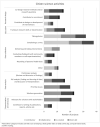A Scoping Review of Citizen Science Approaches in Chronic Disease Prevention
- PMID: 35615030
- PMCID: PMC9125037
- DOI: 10.3389/fpubh.2022.743348
A Scoping Review of Citizen Science Approaches in Chronic Disease Prevention
Abstract
Background: Citizen science approaches, which involve members of the public as active collaborators in scientific research, are increasingly being recognized for their potential benefits in chronic disease prevention. However, understanding the potential applicability, feasibility and impacts of these approaches is necessary if they are to be more widely used. This study aimed to synthesize research that has applied and evaluated citizen science approaches in chronic disease prevention and identify key questions, gaps, and opportunities to inform future work in this field.
Methods: We searched six databases (Scopus, Medline, Embase, PsycInfo, PubMed, and CINAHL) in January 2022 to identify articles on the use of citizen science in prevention. We extracted and synthesized data on key characteristics of citizen science projects, including topics, aims and level of involvement of citizen scientists, as well as methods and findings of evaluations of these projects.
Results: Eighty-one articles reported on citizen science across a variety of health issues, predominantly physical activity and/or nutrition. Projects primarily aimed to identify problems from the perspective of community members; generate and prioritize solutions; develop, test or evaluate interventions; or build community capacity. Most projects were small-scale, and few were co-produced with policy or practice stakeholders. While around half of projects included an evaluation component, overall, there was a lack of robust, in-depth evaluations of the processes and impacts of citizen science projects.
Conclusions: Citizen science approaches are increasingly being used in chronic disease prevention to identify and prioritize community-focused solutions, mobilize support and advocacy, and empower communities to take action to support their health and wellbeing. However, to realize the potential of this approach more attention needs to be paid to demonstrating the feasibility of using citizen science approaches at scale, and to rigorous evaluation of impacts from using these approaches for the diverse stakeholders involved.
Keywords: chronic disease prevention; citizen science (CS); community engagement (CE); health policy; health promotion; participatory research (PR); public health.
Copyright © 2022 Marks, Laird, Trevena, Smith and Rowbotham.
Conflict of interest statement
The authors declare that the research was conducted in the absence of any commercial or financial relationships that could be construed as a potential conflict of interest.
Figures





References
-
- World Health Organization . Global Status Report on Noncommunicable Diseases 2010. Geneva: WHO; (2011).
-
- World Health Organization . WHO Global Meeting to Accelerate Progress on SDG Target 3.4 on Noncommunicable Diseases and Mental Health, 9–12 December 2019. Muscat: Meeting Report; (2020). - PubMed
-
- World Health Organization . Community Engagement for Quality, Integrated, People-Centred and Resilient Health Services. WHO. Available online at: https://www.who.int/servicedeliverysafety/areas/qhc/community-engagement... (accessed June 14, 2021).
-
- National Health and Medical Research Council . Statement on Consumer and Community Involvement in Health and Medical Research. Canberra, ACT: Australian Government; (2016).
Publication types
MeSH terms
LinkOut - more resources
Full Text Sources
Research Materials

